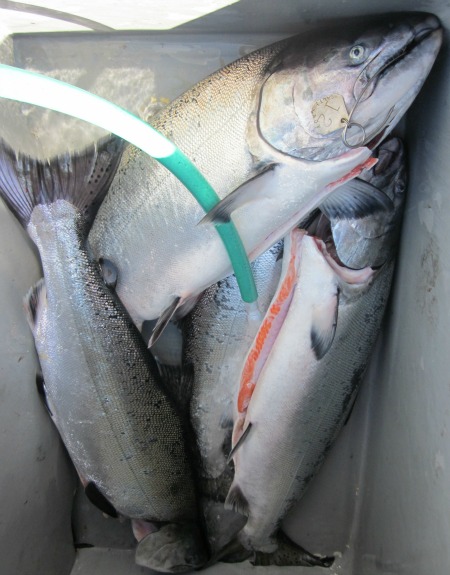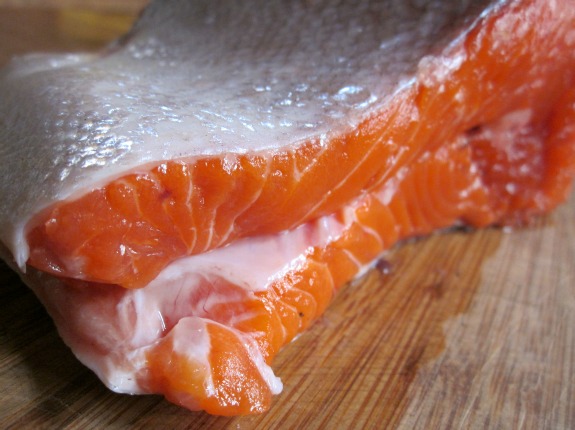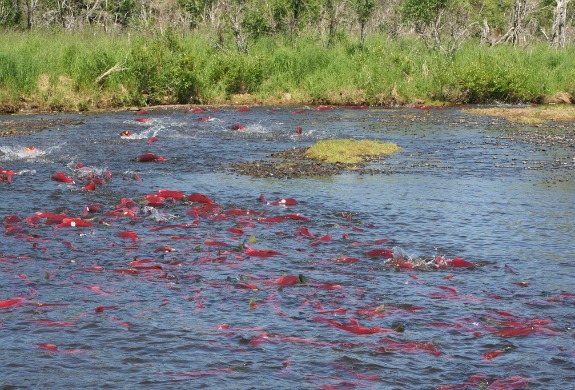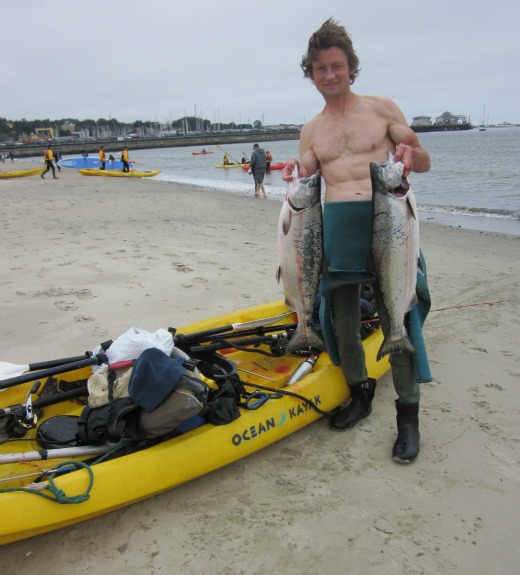Return of the King Salmon
In the ocean waters just off California’s Central Coast, the fish are swarming this summer like they haven’t in years
The beaches of Monterey, California—and nearby sites, like Cannery Row and the Monterey Bay Aquarium—are a fine place to spend a summer Sunday afternoon, but it’s two miles due west and 100 feet straight down that the salmon are teeming. This pair of kings was caught from a kayak. Photo by Andrew Bland.
California draws millions of visitors each summer with a wide variety of natural and cultural attractions—like Yosemite National Park, whose astounding cliffs are proof of either God or glaciers; the brutal but beautiful deserts of the south; the astounding Big Sur coast, where cougars and bears roam the upland wilderness as cliffs plunge into the Pacific; the frigid North Coast of Mendocino and Humboldt counties, where the redwoods grow; and, of course, the Golden Gate Bridge, San Francisco’s gateway to the wild lands to the north.
But if you were to come west across the country, aiming for the wonderful Golden State, and overshoot your destination by, oh, five or ten miles, you’d still land in a pretty sweet spot. Because in the ocean waters just off the Central Coast, the Chinook salmon are swarming this summer like they haven’t in years. Commercial fishermen and recreational fishermen alike are elated, with veterans saying it hasn’t been this good in 15 years. Biologists estimate that more than two million adult salmon are now present in coastal waters—more fish than in the past four seasons combined. Fishermen will harvest hundreds of thousands by the season’s end in September, and hundreds of thousands more are expected to swim upstream to spawn in the Sacramento River, laying the eggs of tomorrow’s salmon.
For several years, though, salmon fishing was dismal in California. In fact, the fish seemed on the verge of vanishing. Things hit rock bottom in 2009, when just 39,000 adult fall-run Chinook salmon returned to spawn in the Sacramento—the lowest number ever recorded (in 2002, by comparison, about 800,000 adult fall-run kings returned to spawn). As a result of the crash, which began in about 2007, the fishing season was shortened or entirely closed in 2008, 2009 and 2010, for both commercial and sport fishermen.
The collapse of California’s salmon was likely due to a number of reasons, including complicated natural cycles of ocean productivity and overdrawing of river water from the Sacramento for agricultural use. But the past two years have seen federal restrictions that limit just how much water can be removed from the river system, and just when the pumps may be operated (pumping is now curtailed during the first six months of the year, when millions of baby salmon occupy the river and delta). Salmon enthusiasts credit this new management scheme with the rebound of the fish.

Salmon grow big—and fast. These 15- to 20-pound kings are just 2 1/2 years old. Born in the fall of 2009, they would probably have gone upriver to spawn in October 2012 had they not bitten the wrong anchovy. Photo by Alastair Bland.
And now, at least for a while, the salmon are back, and party boats are packed with day-tripping recreational fishermen. Many of these pay-to-fish vessels leave from Fisherman’s Wharf in San Francisco, and if you’re a tourist in town for several days, well, OK, do all the guidebook things you came here for. Then, get to the fun stuff: Pay $100 to a local skipper and hop aboard, spend a day at sea and, with just a little luck, reel in one of the most prized food fishes in the world. Across the Golden Gate Bridge, the Salty Lady party boat and several others run out of Sausalito. You’ll need a state recreational fishing license, which can be purchased on board most vessels.
Salmon fishing involves either dangling baited hooks off of a drifting boat—called mooching—or dragging baits or flashing steel lures behind the boat at slow speeds—called trolling. Salmon are aggressive, and they swim in schools, so it’s common that every fisherman on a boat will hook up at once—and that means mayhem. At the surface 50 feet off the rail, hooked salmon will thrash and leap. Lines will cross. Reels will scream as the fish run for the horizon. Sometimes, sea lions will dash in and seize a fish as anglers curse their misfortune. Finally, the landing nets come out, and exhausted fish are lifted aboard. On the very best days, everyone on board has his or her two-salmon limit in an hour or two. Then, it’s nap time as the loaded boat returns home, under the Golden Gate Bridge, and back to the wharf.
The Chinook salmon, though a thrill to battle on the end of a fishing line, is less a brag-about trophy fish as simply a food item. The flesh of the Chinook, as red as the Golden Gate Bridge, is the fattiest of all the Pacific salmon, and the most esteemed by seafood lovers. A salmon’s diet affects just how good it will taste. Off the California coast, boat skippers use fish-finding technology to locate schools of anchovies and herring, around which the salmon are likely to be found, stuffing their gullets with the four-inch bait fish—but it’s a salmon fat on krill that experienced fishermen assure is the best of all.
Salmon, like people, pack on fat around their bellies—and the belly meat may be the tastiest part of the fish. Salmon are best cut into steaks, then barbecued or broiled. Be sure to put a sheet of tinfoil under the meat to catch those prized omega-3 fatty acids, and drizzle the grease over your brown rice. Boil the heads and tails, and strain the stew through a sieve, to make salmon stock. Let nothing go to waste. This is a prized food resource that may not be here forever. Savor it. Appreciate it. Incredibly, some fishermen, wanting only clean muscle, will trim away and discard the succulent belly meat—so if you see a harbor fish-cleaning table, hang out a while. When an angler comes along to fillet his salmon, kindly ask for the scraps. You just might go away with a sack of grade-A salmon.

The sea’s sweetest prize—the fatty, tender belly meat of a wild, krill-fed Chinook salmon. Photo by Alastair Bland.
More West Coast Salmon Fishing Opportunities
The Sacramento River isn’t the only West Coast watershed in which salmon are rebounding. Numbers of Klamath River Chinook salmon are up this summer, as are the sockeyes in the Columbia River, where the current run is looking to be a record setter. More than 400,000 of the three- to eight-pound fish are expected to enter the river basin this year—a tremendous increase over past years. Consider 1995, when just 9,000 sockeyes spawned in the Columbia River basin. It was then that many people feared the species would need federal protection via the Endangered Species Act—which could have shut down fishing indefinitely. But, instead, management of the hydroelectric dams blamed for the sockeye decline was altered, and the fish made a comeback. If you go, you’ll need a fishing license and a “salmon endorsement” stamp.
And in Alaska, naming the rivers in which to fish for salmon would take me all day. Indeed, this final frontier remains the place where salmon fishermen go to heaven. At least, I hope so. Don’t forget to buy your fishing license (and if you want Chinook salmon, you’ll need a supplemental king salmon stamp). With your paperwork tucked away in your wallet, Alaska becomes your oyster—and it’s jampacked with pearls. All five Pacific salmon species spawn in large numbers in most Alaskan streams. Pink salmon swarm into nearly every waterway wider than three feet, but they’re the least tasty salmon. Chums, or keta, are good. Sockeyes and cohos are outstanding. But the Chinook is the king.
The Future
Salmon are in trouble. The Sacramento River’s population is strong at the moment, but the proposal to build a “peripheral canal” to convey water from the Sacramento River to farmlands south of the delta could, if poorly executed, kill the river’s Chinook runs for good. And in Alaska, the Pebble Mine project threatens to devastate the drainage system of Bristol Bay, currently the world’s sockeye salmon capital. Other threats to salmon populations are less understood. Biologists from Simon Fraser University, for example, concluded a study this July in which they found productivity of spawning sockeye salmon to be steadily declining. That is, whereas each adult Fraser River sockeye salmon produced about 20 next-generation adults in the 1960s, an adult fish today produces as few as three, according to the report. This trend has occurred on a wide scale, from Puget Sound north to Alaska—and no one is certain why.

This Alaskan stream in the Bristol Bay drainage is filled with migrating sockeye salmon, which turn from silver to brilliant red before spawning. Such abundance may be threatened by a proposed mining project. Photo courtesy of Flickr user toddraden.
Planning Your Next Trip?
Explore great travel deals
Smithsonian magazine participates in affiliate link advertising programs. If you purchase an item through these links, we receive a commission.
/https://tf-cmsv2-smithsonianmag-media.s3.amazonaws.com/accounts/headshot/Off-Road-alastair-bland-240.jpg)

/https://tf-cmsv2-smithsonianmag-media.s3.amazonaws.com/accounts/headshot/Off-Road-alastair-bland-240.jpg)